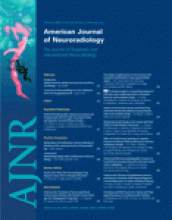Abstract
BACKGROUND AND PURPOSE: Mamillary body and fornix asymmetry are frequent findings on MR imaging of the brain. We sought to determine the prevalence of asymmetry of the fornix and mamillary body on MR imaging in patients with or without seizures.
MATERIALS AND METHODS: MR images were retrospectively evaluated for asymmetry of the mamillary body and fornix in 178 patients who had a history of seizures, of whom 35 had suspected mesial temporal sclerosis (MTS). Additionally, 353 patients who had no limbic system pathology were reviewed. All patients were examined with spin-echo MR imaging, consisting of contiguous axial and/or coronal fluid-attenuated inversion recovery (FLAIR), T2-weighted, and sagittal T1-weighted imaging. Additionally, the patients with seizures had oblique coronal 3-mm T2-weighted, FLAIR, and 1.5-mm magnetization-preparation rapid gradient echo scanning through their temporal lobes.
RESULTS: In the patients who had no limbic system pathology or seizure history, 6.5% (23/353) had MR imaging evidence of asymmetric mamillary bodies and 7.9% (28/353) had asymmetric fornix size. Asymmetry of the mamillary body and fornix size was found in 37.1% (13/35) and 34.3% (12/35), respectively, of subjects with suggested hippocampal sclerosis. The prevalence of asymmetry of the mamillary body and fornix was statistically significantly higher in the patients with MTS (χ2 test, P <.0001).
CONCLUSION: Although asymmetry of the mamillary bodies and fornices is highly associated with MTS, this could also be seen as a normal variation or congenital abnormality.
- Copyright © American Society of Neuroradiology












